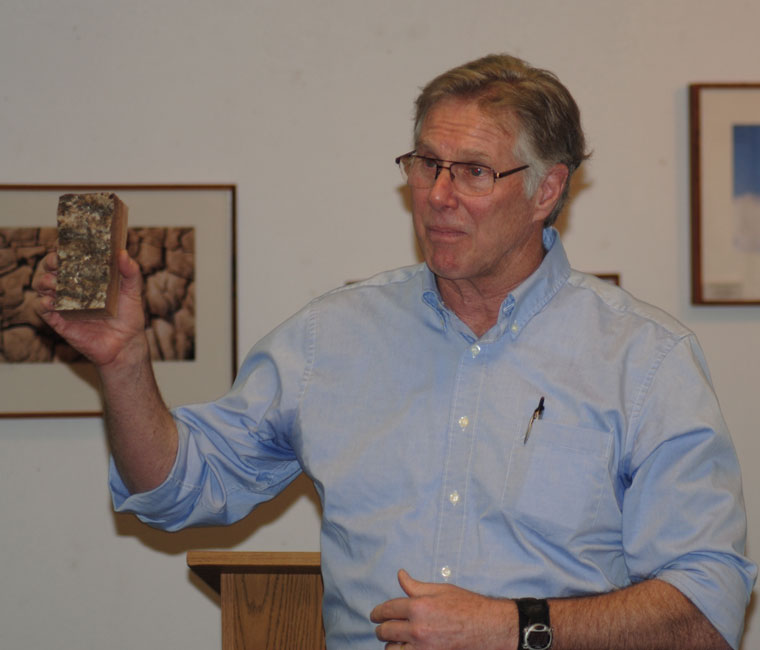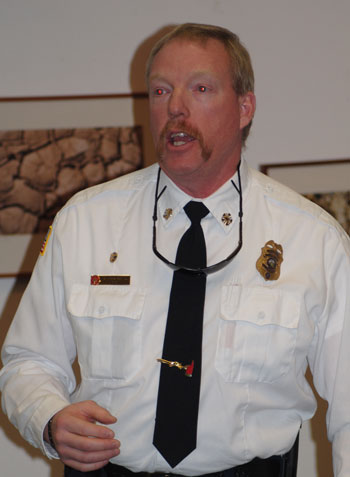
Photo by JP Crumrine
The Goldspotted oak borer has devastated oak forests in San Diego County. In some areas, oak mortality has approached 100 percent, according to Kim Corella, forest pest specialist with Cal Fire.

Photo by JP Crumrine
Experts believe the GSOB migrated from Mexico to Arizona and then hitched rides in vehicles transporting firewood to San Diego County in the early and mid 2000s. By 2008 and 2009, oaks were dying in massive numbers.
In November 2012, the GSOB was found in Idyllwild. Dr. Tom Scott, with the University of California units at both Berkeley and Riverside, and others believe the insect arrived here in firewood several years earlier.
Entomologists who study the GSOB say that it is capable of flying about half a mile per day. Therefore, its migration to California, and even to Idyllwild, was most likely in firewood.

Photo by JP Crumrine
“Even within Idyllwild, you shouldn’t be moving oak,” Scott stressed. “Don’t move firewood.”
Saturday at the Mountain Community Fire Safe Council session, Unit Forester Gregg Bratcher for Riverside County Fire Department and Cal Fire, reported that the GSOB has infested at least 178 oaks on the Hill. Another 29 infested or dead oaks have been found on U.S. Forest Service land, for a total of more than 200 identified GSOB-infested oaks on the Hill.

While that’s a large number, Scott stressed that this represents a 4-percent tree mortality of the oaks on the Hill. Natural mortality in an extreme drought would be about 10 percent. Cal Fire’s efforts and the numerous local volunteers, led by MCFSC, have been extremely successful in limiting the damage, according to Scott.
The adult GSOB lays the eggs in the outer bark of the oak. The larvae eat into the cambium layer of the tree. Enough larvae will damage the cambium and diminish or stop the flow of nutrients to the tree’s newest limbs and leaves.
“In essence, it’s being starved to death,” said Andrea Hefty, forest entomologist with the U.S. Forest Service. “Then in the spring, the adults emerge and feed on the crown of the tree.”
GSOB’s most likely targets are the coast live oak, the California black oak and occasionally, the canyon live oak. They prefer large-diameter trees, greater than 20 inches diameter breast high.
The U.S. Forest Service has identified 29 infested trees on the San Jacinto Ranger District. The areas range from Pine Cove to Idyllwild and include Garner Valley. Recently, more oaks in Fern Valley have been found with GSOB markers.

Patrick Reitz, Idyllwild Fire chief.
Photo by JP Crumrine
Since the discovery of the GSOB in Idyllwild in 2014, it was identified in Weir Canyon in Orange County. One year later, in 2015, it was found in Green Valley in Los Angeles County.
Compared to Idyllwild, its impact has already been greater in these areas. Of 781 oak trees in Weir Canyon, 280 have been infested. In Green Valley, 233 of 1,185 trees were infested.
After seeing the destruction the insect created in the San Diego County oak forests, the response from officials in Riverside, Los Angeles and Orange counties has been much more aggressive.
For example, Bratcher said trees identified as infested will be taken down and removed within 72 hours during the spring and summer. Currently, 31 trees found this fall will be removed before flight season this coming spring.
But entomologists and forest experts have been experimenting with treatments and removal techniques. If the bark is removed and then put through a small grinder, the firewood may be left for the property owner’s use, according to Bratcher.
GSOB Program Coordinator Kevin Turner of the University of California, Riverside, and Scott said there may be some pesticides and systemic insecticides capable of killing or limiting the adults before they emerge and fly in the spring. This might be a way to save the high-value trees but will not save heavily infested trees.
“But use someone licensed. Don’t do it yourself,” Scott added.
“The public still needs to be vigilant,” Bratcher emphasized. If a property owner has any questions about the GSOB or oaks on their property, call the GSOB hotline at 951-659-8328. MCFSC will send someone to answer questions or inspect the tree for exit holes, he stated.
The response in Idyllwild to the GSOB has been recognized elsewhere. Scott said, “You have no idea what you’re doing for the interest of the state. It’s not the palm tree that identifies California, it’s the old oak trees.”










